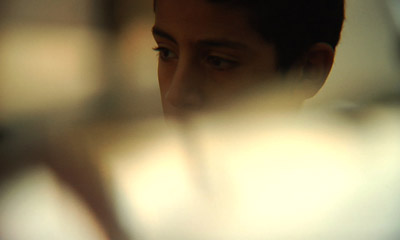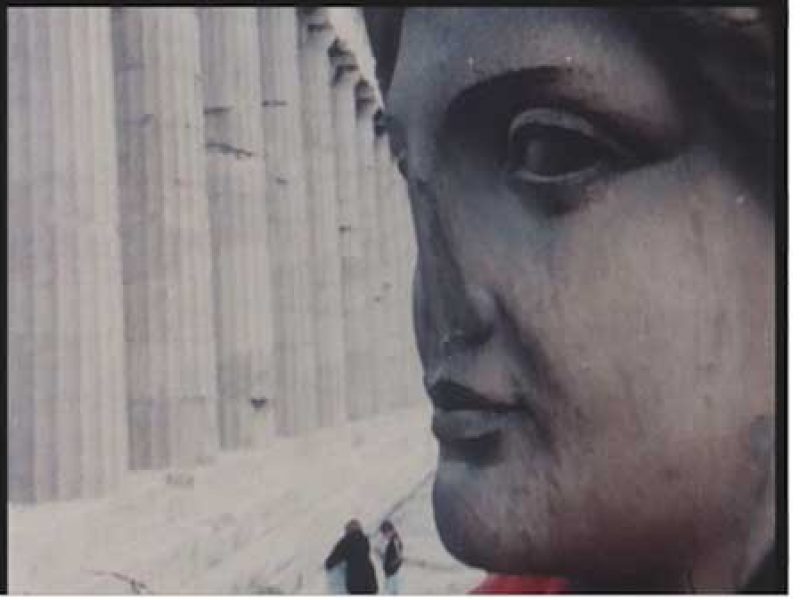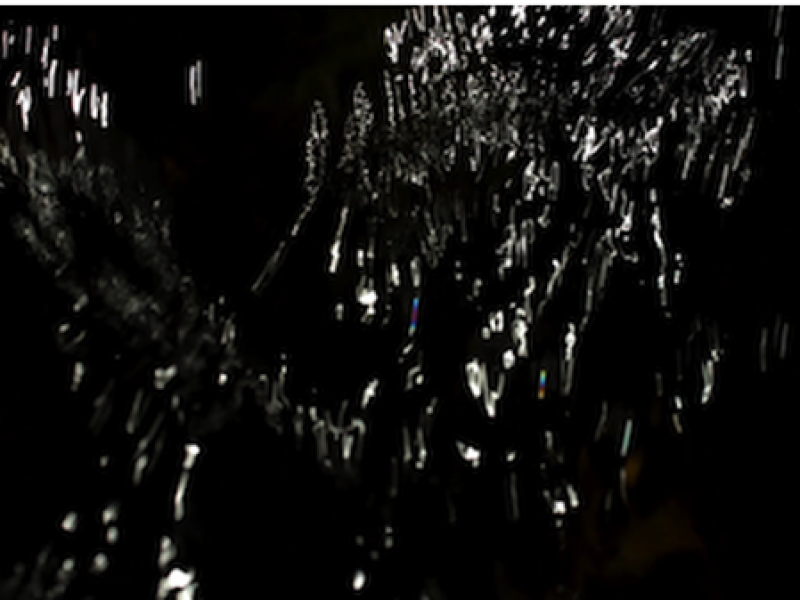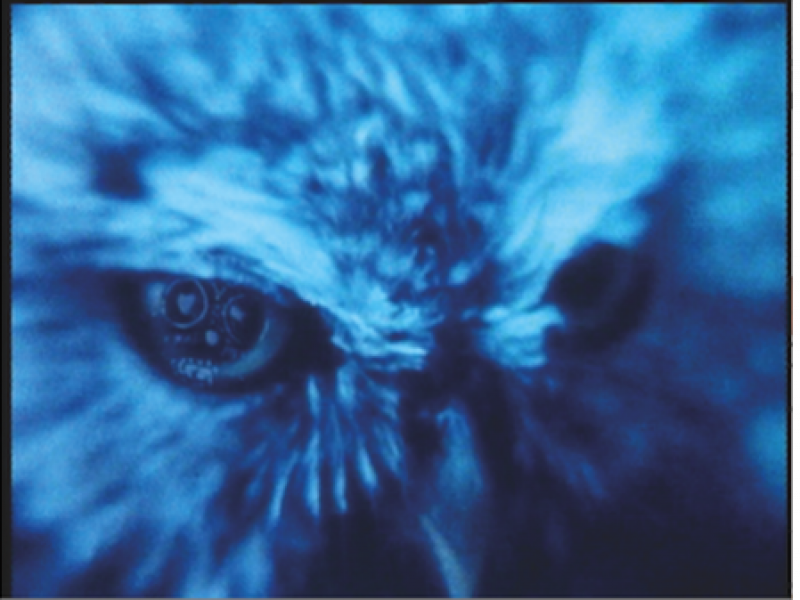The Otolith Group is an artist-led collective that was founded in 2000 by the London based artists Anjalika Sagar and Kodwo Eshun. Their work is distributed by the LUX Collection. Last month Tate announced The Otolith Group is one of the shortlisted candidates for the Turner Prize 2010 for their 2009 project A Long Time Between Suns, which took the form of exhibitions at Gasworks and The Showroom, London and an accompanying publication. Work by the shortlisted artists will be shown in an exhibition at Tate Britain opening on 4 October 2010, and the winner will be announced at Tate Britain on 6 December 2010 during a live broadcast by Channel 4. Read on for writer and curator Georgia Korossi’s essay introducing the group’s practice; part of our new writing series on the work of artists recently taken into the LUX Collection.
In 2000 artist and moderator Anjalika Sagar and artist, writer and theorist Kodwo Eshun founded The Otolith Group as a platform for production and dialogue across contemporary art practice. The Group are interested in histories of futurity, the legacies of the Non–Alignment movement as expressed through India’s colonial experience and its relations with countries outside South Asia, and cultural exchange. Artist Richard Couzins was a participant in the making of Otolith in 2003, the first part in The Otolith Trilogy that was commissioned by The Arts Catalyst and the MIR consortium and from which the Group’s name derives.
Otolith takes its name from a structure of organs in the inner ear that are sensitive to gravity and linear acceleration. Scientific studies have evidenced that the otolith organs have significant characteristics in fish ecology and palaeontology through which leading researchers have identified the possibility of tracing where fish have traveled. The name’s formal significance provides a coherent image of the Group’s wider interest in the archaeologies of futurity. Their work emerges from questions of memory and fantasy, a condition of individuality which French theorist and psychoanalyst Jean Laplanche describes as a ‘time of human subject’ in The Language of Psycho-Analysis (1973), co-authored with Jean-Baptiste Pontalis.
Sagar, who has shown her work internationally and produced numerous projects including No Arrival No Parking, Almeida Opera’s large-scale outreach where composer Heiner Goebbels headed a group of co-ordinating minds to mastermind a Sound City project in a workshop setting, is also founder of Multitudes, the independent news network established in 2000, and moderator of Undercurrents listserve. Eshun is course leader of the MA in Aural and Visual Cultures at Goldsmiths, author of the acclaimed More Brilliant Than The Sun: Adventures in Sonic Fiction (1998: Quartet) and a Trustee of Artangel, one of the few UK bodies to commission art projects that stimulate national debate.
The savvy modes of The Otolith Group’s practice pave the way towards the understanding of the Archive (physical, historical or ontological and regardless of media and format) as a chain of fascinating conditions of futurity outside authoritarian boundaries and utopian ideals. Their manifesto – to encounter the environment of media with the use of the primary processes of film, exhibition, lectures and found footage – mixes fiction and archival material to investigate their relationship and deciphering narratives.
The Group’s engagement with these different modes of production results in the exploration of the essayistic form of moving image, sound, text and dialogue. In their diverse work of near documentary historiographic resonance, The Otolith Group see the material presence of film as the kernel of collective memory activating archive and contemporary media (Otolith) across a broad spectrum of reportage, discussion and production (Otolith II) that generate narratives based around unfulfilled directorial debuts and past potential futures (Otolith III).
The Otolith Group’s first film, Otolith (2003) (click here for a short clip), is set in the fictional 2103 when the human race only exists outside earth’s gravity, and it features the future descendant of Anjalika Sagar who researches expired life on earth via collected media archives. Otolith II (2007) explores visions of a closer future and the life of inhabitants living in the present city of tomorrow by using archive film footage of Mumbai and Chandigarh. The final film in The Otolith Trilogy, Otolith III (2009) is informed by Satyajit Ray’s unmade film The Alien (1967) and Pier Paolo Pasolini’s Appunti per un film sull’India (1968). It is a single screen projection that resurrects Ray’s unrealized science fiction, 1960s London and the artist’s inner world in the instant light of almost voyeuristic close ups of the featured character (artist Vidya Sagar) and street cast.
 Image: The Otolith Group, Otolith II (2007), still. Courtesy The Otolith Group
Image: The Otolith Group, Otolith II (2007), still. Courtesy The Otolith Group
Undoubtedly the fictional narratives and feelings in The Otolith Trilogy bring to mind the work of Free Cinema, the groundbreaking documentary movement of the late 1950s, as well as the purity of 1970s filmmaking of commercial independence, of the documentary approach in the films of John Akomfrah, and of Jacques Rancière’s call of disagreement for ‘The Distribution of the Sensible’ in politics and aesthetics. Imposing no hierarchical relationship between the personal and the official, The Otolith Group’s work emerges from a polyphonic array of contemporary production, curation and dialogue examining existing imagery, the remembered film and the historical context of transcultural exchange.
 Image: The Otolith Group, Otolith III (2009), still. Courtesy The Otolith Group
Image: The Otolith Group, Otolith III (2009), still. Courtesy The Otolith Group
The influence of archive futurities as staged in the work of The Otolith Group, most notably in their installation Inner time of television (2007), a collaborative project with Chris Marker presented at DESTROY ATHENS, 1st Biennial of Athens, plays a captivating role in the structuring common language of contemporary art practices such as Matthew Buckingham’s cinema, Neil Cummings’ and Marysia Lewandowska’s research, The Atlas Group’s foundation, the ‘Frankenstein self’ emerging from Lindsay Seers’ transformation into a film projector and many more that examine the role of the archive within contemporary art. As with their Inner time of television that made Chris Marker’s 13 part television series The Owl’s Legacy (1989) available for viewing in Greece for the first time, the group’s work adopts qualities that potentially enrich the public with questions of accessibility and freedom in interacting with true events.
Noteworthy, The Owl’s Legacy series bear the potentials and afterlives of Ancient Greece with guest speakers including expatriates such as political philosopher Cornelius Castoriadis and singer Angelique Ionatos as well as composer Iannis Xenakis and novelist Vassilis Vassilikos who were both forced into exile. From perception to reconfiguration of visual language, family diaries and philosophical implications of microgravity (Otolith), The Otolith Group’s work can be understood as an anthropological exemplification of historical ruins and anecdotes that epitomizes the burning desire to document in our audiovisual culture.
The Otolith Group’s films and installations have featured widely in international exhibitions including Documenta 12, Kassel (2007), Just In Time, The Stedelijk Museum: Amsterdam (2006), The Unhomely: 2nd International Biennial of Contemporary Art Seville (2006), and How to Improve the World: 60 Years of British Art, Hayward Gallery: London (2006). The Group curated and produced The Ghosts of Songs: A Retrospective of The Black Audio Film Collective 1982-1998 which toured in UK for two years from 2007. In 2008, the Group received the prestigious LAFVA Award.
In 2009 they had their first solo exhibition in London, the two-venue presentation of ‘A Long Time Between Suns’. Part 1 was presented at Gasworks during which they also held the screening of their 2008 film Nervus Rerum at Tate Britain. Part 2 was the inaugural exhibition marking the reopening of The Showroom in September 2009 and premiers Otolith III. Throughout 2009 The Otolith Group also co-curated a major exhibition on the work of Harun Farocki for Cubitt Gallery (Jan-Feb) and Tate Modern (throughout November), presented The Otolith Trilogy at Il Trifoglio Nero, Genoa, Italy, and will publish their monograph, published by Sternberg Press in collaboration with The Showroom and Gasworks, London, MACBA, Barcelona, and Fondazione Galleria Civica – Centro di Ricerca sulla Contemporaneità di Trento.
Georgia Korossi is a curator and writer based in London and Athens. She is a PhD researcher of Cultural History and Visual Arts at Goldsmiths College, contributor to KAPUT art magazine and since 2006 she has been a coordinator to BFI Screenonline and Mediatheque projects that draw public access gateways to the BFI National Archive.
Click here to read more about works by The Otolith Group distributed by the LUX Collection. otolithgroup.org



 Image: The Otolith Group, Otolith II (2007), still. Courtesy The Otolith Group
Image: The Otolith Group, Otolith II (2007), still. Courtesy The Otolith Group Image: The Otolith Group, Otolith III (2009), still. Courtesy The Otolith Group
Image: The Otolith Group, Otolith III (2009), still. Courtesy The Otolith Group




